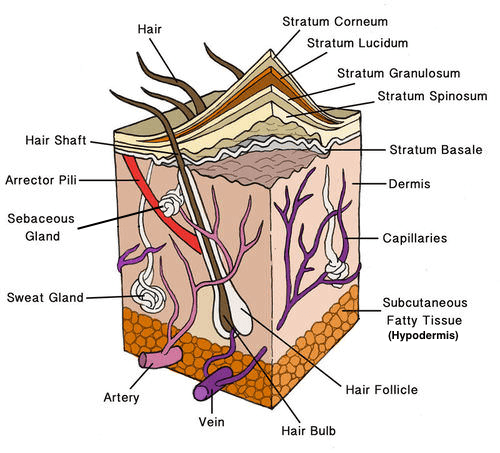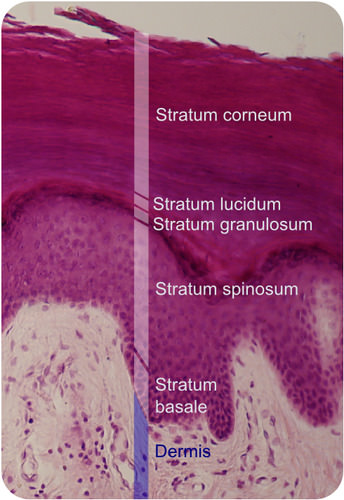13.2: Skin
- Page ID
- 13273
\( \newcommand{\vecs}[1]{\overset { \scriptstyle \rightharpoonup} {\mathbf{#1}} } \)
\( \newcommand{\vecd}[1]{\overset{-\!-\!\rightharpoonup}{\vphantom{a}\smash {#1}}} \)
\( \newcommand{\dsum}{\displaystyle\sum\limits} \)
\( \newcommand{\dint}{\displaystyle\int\limits} \)
\( \newcommand{\dlim}{\displaystyle\lim\limits} \)
\( \newcommand{\id}{\mathrm{id}}\) \( \newcommand{\Span}{\mathrm{span}}\)
( \newcommand{\kernel}{\mathrm{null}\,}\) \( \newcommand{\range}{\mathrm{range}\,}\)
\( \newcommand{\RealPart}{\mathrm{Re}}\) \( \newcommand{\ImaginaryPart}{\mathrm{Im}}\)
\( \newcommand{\Argument}{\mathrm{Arg}}\) \( \newcommand{\norm}[1]{\| #1 \|}\)
\( \newcommand{\inner}[2]{\langle #1, #2 \rangle}\)
\( \newcommand{\Span}{\mathrm{span}}\)
\( \newcommand{\id}{\mathrm{id}}\)
\( \newcommand{\Span}{\mathrm{span}}\)
\( \newcommand{\kernel}{\mathrm{null}\,}\)
\( \newcommand{\range}{\mathrm{range}\,}\)
\( \newcommand{\RealPart}{\mathrm{Re}}\)
\( \newcommand{\ImaginaryPart}{\mathrm{Im}}\)
\( \newcommand{\Argument}{\mathrm{Arg}}\)
\( \newcommand{\norm}[1]{\| #1 \|}\)
\( \newcommand{\inner}[2]{\langle #1, #2 \rangle}\)
\( \newcommand{\Span}{\mathrm{span}}\) \( \newcommand{\AA}{\unicode[.8,0]{x212B}}\)
\( \newcommand{\vectorA}[1]{\vec{#1}} % arrow\)
\( \newcommand{\vectorAt}[1]{\vec{\text{#1}}} % arrow\)
\( \newcommand{\vectorB}[1]{\overset { \scriptstyle \rightharpoonup} {\mathbf{#1}} } \)
\( \newcommand{\vectorC}[1]{\textbf{#1}} \)
\( \newcommand{\vectorD}[1]{\overrightarrow{#1}} \)
\( \newcommand{\vectorDt}[1]{\overrightarrow{\text{#1}}} \)
\( \newcommand{\vectE}[1]{\overset{-\!-\!\rightharpoonup}{\vphantom{a}\smash{\mathbf {#1}}}} \)
\( \newcommand{\vecs}[1]{\overset { \scriptstyle \rightharpoonup} {\mathbf{#1}} } \)
\( \newcommand{\vecd}[1]{\overset{-\!-\!\rightharpoonup}{\vphantom{a}\smash {#1}}} \)
\(\newcommand{\avec}{\mathbf a}\) \(\newcommand{\bvec}{\mathbf b}\) \(\newcommand{\cvec}{\mathbf c}\) \(\newcommand{\dvec}{\mathbf d}\) \(\newcommand{\dtil}{\widetilde{\mathbf d}}\) \(\newcommand{\evec}{\mathbf e}\) \(\newcommand{\fvec}{\mathbf f}\) \(\newcommand{\nvec}{\mathbf n}\) \(\newcommand{\pvec}{\mathbf p}\) \(\newcommand{\qvec}{\mathbf q}\) \(\newcommand{\svec}{\mathbf s}\) \(\newcommand{\tvec}{\mathbf t}\) \(\newcommand{\uvec}{\mathbf u}\) \(\newcommand{\vvec}{\mathbf v}\) \(\newcommand{\wvec}{\mathbf w}\) \(\newcommand{\xvec}{\mathbf x}\) \(\newcommand{\yvec}{\mathbf y}\) \(\newcommand{\zvec}{\mathbf z}\) \(\newcommand{\rvec}{\mathbf r}\) \(\newcommand{\mvec}{\mathbf m}\) \(\newcommand{\zerovec}{\mathbf 0}\) \(\newcommand{\onevec}{\mathbf 1}\) \(\newcommand{\real}{\mathbb R}\) \(\newcommand{\twovec}[2]{\left[\begin{array}{r}#1 \\ #2 \end{array}\right]}\) \(\newcommand{\ctwovec}[2]{\left[\begin{array}{c}#1 \\ #2 \end{array}\right]}\) \(\newcommand{\threevec}[3]{\left[\begin{array}{r}#1 \\ #2 \\ #3 \end{array}\right]}\) \(\newcommand{\cthreevec}[3]{\left[\begin{array}{c}#1 \\ #2 \\ #3 \end{array}\right]}\) \(\newcommand{\fourvec}[4]{\left[\begin{array}{r}#1 \\ #2 \\ #3 \\ #4 \end{array}\right]}\) \(\newcommand{\cfourvec}[4]{\left[\begin{array}{c}#1 \\ #2 \\ #3 \\ #4 \end{array}\right]}\) \(\newcommand{\fivevec}[5]{\left[\begin{array}{r}#1 \\ #2 \\ #3 \\ #4 \\ #5 \\ \end{array}\right]}\) \(\newcommand{\cfivevec}[5]{\left[\begin{array}{c}#1 \\ #2 \\ #3 \\ #4 \\ #5 \\ \end{array}\right]}\) \(\newcommand{\mattwo}[4]{\left[\begin{array}{rr}#1 \amp #2 \\ #3 \amp #4 \\ \end{array}\right]}\) \(\newcommand{\laspan}[1]{\text{Span}\{#1\}}\) \(\newcommand{\bcal}{\cal B}\) \(\newcommand{\ccal}{\cal C}\) \(\newcommand{\scal}{\cal S}\) \(\newcommand{\wcal}{\cal W}\) \(\newcommand{\ecal}{\cal E}\) \(\newcommand{\coords}[2]{\left\{#1\right\}_{#2}}\) \(\newcommand{\gray}[1]{\color{gray}{#1}}\) \(\newcommand{\lgray}[1]{\color{lightgray}{#1}}\) \(\newcommand{\rank}{\operatorname{rank}}\) \(\newcommand{\row}{\text{Row}}\) \(\newcommand{\col}{\text{Col}}\) \(\renewcommand{\row}{\text{Row}}\) \(\newcommand{\nul}{\text{Nul}}\) \(\newcommand{\var}{\text{Var}}\) \(\newcommand{\corr}{\text{corr}}\) \(\newcommand{\len}[1]{\left|#1\right|}\) \(\newcommand{\bbar}{\overline{\bvec}}\) \(\newcommand{\bhat}{\widehat{\bvec}}\) \(\newcommand{\bperp}{\bvec^\perp}\) \(\newcommand{\xhat}{\widehat{\xvec}}\) \(\newcommand{\vhat}{\widehat{\vvec}}\) \(\newcommand{\uhat}{\widehat{\uvec}}\) \(\newcommand{\what}{\widehat{\wvec}}\) \(\newcommand{\Sighat}{\widehat{\Sigma}}\) \(\newcommand{\lt}{<}\) \(\newcommand{\gt}{>}\) \(\newcommand{\amp}{&}\) \(\definecolor{fillinmathshade}{gray}{0.9}\)What is integumentary?
Because the organs of the integumentary system are external to the body, you may think of them as little more than “accessories,” like clothing or jewelry. But the organs of the integumentary system serve important biological functions. They provide a protective covering for the body and help the body maintain homeostasis.
The Skin
The skin is the major organ of the integumentary system, which also includes the nails and hair. In fact, the skin is the body’s largest organ, and a remarkable one at that. Consider these skin facts. The average square inch (6.5 cm2) of skin has 20 blood vessels, 650 sweat glands, and more than a thousand nerve endings. It also has an incredible 60,000 pigment-producing cells. All of these structures are packed into a stack of cells that is just 2 mm thick, or about as thick as the cover of a book.
Although the skin is thin, it consists of two distinct layers, called the epidermis and the dermis. These layers are shown in Figure below.

Layers of Human Skin. The outer layer of the skin is the epidermis, and the inner layer is the dermis. Most skin structures originate in the dermis.
Epidermis
The epidermis is the outer layer of skin, consisting of epithelial cells and little else (see Figure below). For example, there are no nerve endings or blood vessels in the epidermis. The innermost cells of the epidermis are continuously dividing through mitosis to form new cells. The newly formed cells move up through the epidermis toward the skin surface, while producing a tough, fibrous protein called keratin. The cells become filled with keratin and die by the time they reach the surface, where they form a protective, waterproof layer called the stratum corneum. The dead cells are gradually shed from the surface of the skin and replaced by other cells.

Cell Layers of the Epidermis. The epidermis consists mainly of epithelial cells.
The epidermis also contains melanocytes, which are cells that produce melanin. Melanin is the brownish pigment that gives skin much of its color. Everyone has about the same number of melanocytes, but the melanocytes of people with darker skin produce more melanin. The amount of melanin produced is determined by heredity and exposure to UV light, which increases melanin output. Exposure to UV light also stimulates the skin to produce vitamin D. Because melanin blocks UV light from penetrating the skin, people with darker skin may be at greater risk of vitamin D deficiency.
Dermis
The dermis is the lower layer of the skin, located directly beneath the epidermis (see Figure below). It is made of tough connective tissue and attached to the epidermis by collagen fibers. The dermis contains blood vessels and nerve endings. Because of the nerve endings, skin can feel touch, pressure, heat, cold, and pain. The dermis also contains hair follicles and two types of glands.
- Hair follicles are the structures where hairs originate. Hairs grow out of follicles, pass through the epidermis, and exit at the surface of the skin.
- Sebaceous glands produce an oily substance called sebum. Sebum is secreted into hair follicles and makes its way to the skin surface. It waterproofs the hair and skin and helps prevent them from drying out. Sebum also has antibacterial properties, so it inhibits the growth of microorganisms on the skin.
- Sweat glands produce the salty fluid called sweat, which contains excess water, salts, and other waste products. The glands have ducts that pass through the epidermis and open to the surface through pores in the skin.

Structures of the Dermis. The dermis contains most of the structures found in skin.
Functions of the Skin
The skin has multiple roles in the body. Many of these roles are related to homeostasis. The skin’s main functions are preventing water loss from the body and serving as a barrier to the entry of microorganisms. In addition, melanin in the skin blocks UV light and protects deeper layers from its damaging effects.
The skin also helps regulate body temperature. When the body is too warm, sweat is released by the sweat glands and spreads over the skin surface. As the sweat evaporates, it cools the body. Blood vessels in the skin also dilate, or widen, when the body is too warm. This allows more blood to flow through the skin, bringing body heat to the surface, where it radiates into the environment. When the body is too cool, sweat glands stop producing sweat, and blood vessels in the skin constrict, or narrow, thus conserving body heat.
Skin Problems
In part because it is exposed to the environment, the skin is prone to injury and other problems. Two common problems of the skin are acne and skin cancer (see Figure below).
- Acne is a condition in which red bumps called pimples form on the skin due to a bacterial infection. It affects more than 85 percent of teens and may continue into adulthood. The underlying cause of acne is excessive secretion of sebum, which plugs hair follicles and makes them good breeding grounds for bacteria.
- Skin cancer is a disease in which skin cells grow out of control. It is caused mainly by excessive exposure to UV light. People with lighter skin are at greater risk of developing skin cancer because they have less melanin to block harmful UV radiation. The best way to prevent skin cancer is to avoid UV exposure by using sunscreen and wearing protective clothing.

ABCDs of Skin Cancer. A brown spot on the skin is likely to be a harmless mole, but it could be a sign of skin cancer. Unlike moles, skin cancers are generally asymmetrical, have irregular borders, may be very dark in color, and may have a relatively great diameter.
Further Reading
Summary
- The skin consists of two layers: the epidermis, which contains mainly epithelial cells, and the dermis, which contains most of skin’s other structures, including blood vessels, nerve endings, hair follicles, and glands.
- Skin protects the body from injury, water loss, and microorganisms. It also plays a major role in maintaining a stable body temperature.
- Common skin problems include acne and skin cancer.
Review
- What organs make up the integumentary system?
- Describe how new epidermal cells form, develop, and are shed from the body.
- What is keratin?
- What is the function of the stratum corneum?
- What is acne? What causes acne?
- Assume that you get a paper cut, but it doesn’t bleed. How deep is the cut? How do you know?
- Skin cancer has been increasing over recent decades. What could explain this? (Hint: What is the main cause of skin cancer?)
- Explain how melanin is related to skin color, vitamin D production, and skin cancer.
- Explain how the skin helps the body maintain a stable temperature.
| Image | Reference | Attributions |
 |
[Figure 1] | Credit: Laura Guerin Source: CK-12 Foundation License: CC BY-NC 3.0 |
 |
[Figure 2] | Credit: User:Wbensmith/Wikimedia Commons, modified by Mikael Häggström Source: commons.wikimedia.org/wiki/File:Epidermal_layers.svg License: CC BY 3.0 |
 |
[Figure 3] | Credit: Jodi So and Marianna Ruiz Villarreal (LadyofHats) Source: CK-12 Foundation License: CC BY-NC 3.0 |
 |
[Figure 4] | Credit: Courtesy of Skin Cancer Foundation/National Cancer Institute Source: Left to right: http://visualsonline.cancer.gov/details.cfm?imageid=2362 ; http://visualsonline.cancer.gov/details.cfm?imageid=2363 ; http://visualsonline.cancer.gov/details.cfm?imageid=2364 ; http://visualsonline.cancer.gov/details.cfm?imageid=2184 License: Public Domain |

